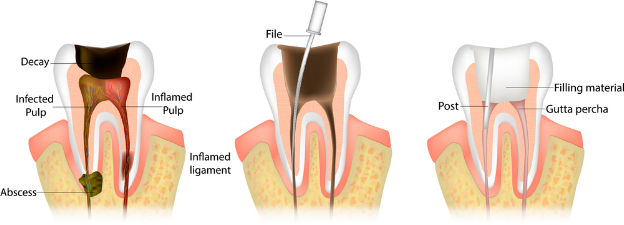
Are you having problems with your tooth? Do you feel pain or sensitivity when chewing or biting down? Is your mouth swollen and uncomfortable? Is your tooth discolored, or is it getting loose? You might think about having these problems fixed with a root canal procedure. A root canal is one of the most popular dental procedures. In this article, we’ll go over all the information you need to make an informed decision about whether or not to have a root canal.
What Is A Root Canal?
The root canal is the most common endodontic treatment. You may need a root canal if you have a damaged or infected tooth. Root canals are performed by dentists or endodontists, a type of dentist specializing in this procedure. Root canals are often necessary when a tooth has become severely decayed or infected. This procedure can also treat cracked teeth and teeth that have been traumatized from injury.
In some cases, a root canal may be necessary to save a tooth that has had extensive work done on it (such as a crown). In this dental procedure, the tissues, also known as the pulp (the soft tissue inside the tooth that contains blood vessels and nerves) that carries pain are removed. Then, an infection in the tooth receives treatment. The purpose of root canal therapy is to save a tooth from having to be extracted and replaced with a permanent tooth prosthesis.
If you leave it untreated, the tissue around the tooth will become infected, and abscesses may form. This abscess results from an infected tooth that can become painful, pus-filled, and difficult to remove. They can also cause serious health problems if not treated promptly. You should get your root canal done soon if you have a tooth problem. About 15 million teeth are saved each year with root canals.
When Root Canal Treatment Is Needed

Root canals are tiny tubules inside our teeth that connect the tooth’s pulp chamber to the dental nerve. When the root canal becomes infected with bacteria, it can cause damage to the tooth and surrounding tissues, which is why they need to be treated.
Symptoms You May Need A Root Canal Treatment Include:
- Severe tooth pain that doesn’t go away with over-the-counter pain medication
- Sensitivity to hot or cold temperatures that lingers long after exposure has ended
- Tenderness or swelling in the gums near the affected tooth
- A visible bump on the gum line near the affected tooth
- Discoloration of the affected tooth
You may need root canal treatment if you experience any of these symptoms. Don’t hesitate to contact your dentist as soon as possible to schedule an appointment. Root canal treatment is a relatively straightforward procedure and a common and effective way to relieve these symptoms.
Some of the benefits of root canal treatment include the following:
- Relief from pain and discomfort
- Prevention of further damage to the tooth
- Restoration of the tooth to its natural appearance
- Root canal treatment can help you avoid costly procedures (such as dental implants or bridges).
- Avoid needing a tooth extraction
How Long Does A Root Canal Take – The Step-by-Step Root Canal Procedure

If you’re considering a root canal, you may wonder how long a root canal treatment takes. The good news is that this procedure is quite short. Usually, this only takes between 30 and 60 minutes to complete. However, the length of time that a root canal takes can vary depending on the severity of the damage to the tooth individual tooth. In most cases, a root canal can be completed in one or two visits to the dentist.
PROCEDURE
The step-by-step procedure includes the following:
- Step 1: The first step in a root canal procedure is to take an x-ray of the tooth to determine the extent of the damage. The dentist then numbs the area around the tooth with a local anesthetic so you can not feel any pain or discomfort during the procedure.
- Step 2: Next, the dentist makes an opening in the top of the tooth (known as crown/cap) and removes the damaged pulp. The inside of the tooth is then cleaned and sealed with a rubber-like material called gutta-percha. A temporary filling is placed in the opening, and the tooth is left to heal for the next appointment.
- Step 3: Finally, the dentist removes the temporary filling in the next appointment and replaces it with a permanent filling or crown. The tooth is now ready to be used just like any other tooth!
Root canals are generally successful in treating infection and saving teeth. However, there is a small risk of complications such as pain, swelling, and inflammation. In addition, there is a slight chance that the tooth could become infected again after the procedure. For this reason, it is essential to take care of your teeth afterward. If this does begin to happen, you may need to have another root canal or have the tooth removed.
You may also experience some soreness and sensitivity for a few days after the procedure, but this can be easily managed with over-the-counter pain medication. Contact your endodontist immediately if you experience these symptoms after your operation. With proper care, your newly treated tooth can last a lifetime!
Aftercare And Recovery: How To Take Care Of Your Tooth
Now that you’ve had a root canal, aftercare is critical to ensure proper healing and to avoid complications after the procedure. Here are some tips for taking care of your tooth after endodontic/root canal treatment:
- Avoid chewing on hard foods for the first few days after your procedure.
- Avoid using tobacco products
- Eat soft foods and avoid hot drinks for the first 24 hours.
- Use a straw when drinking beverages
- Take over-the-counter pain medication as needed.
- Use ice packs or warm compresses to relieve pain and swelling.
- Rinse your mouth with warm salt water several times a day.
- Brush and floss your teeth as usual, but be gentle around the area where you had your procedure.
With proper care, your tooth should heal quickly, and you can resume your normal activities within a week or so. You should see your dentist for a follow-up visit to ensure that your root canal is healing correctly. Following these aftercare instructions will help you recover quickly and avoid complications. If you have any questions or concerns, contact your dentist.
How Much Does A Root Canal Cost
Root canals are not always cheap. The average cost of a root canal is between $600 and $1500, and with the crown, this cost can easily go over $2500. Still, the price of a root canal will vary depending on various conditions. For example, it depends on the severity of the infection, the number of roots that need to be treated, and the tooth’s location, whether it is a Front Tooth, Premolar, or Molar tooth. Also, who is performing the treatment (Generally, a specialist costs more than an ordinary dentist) and whether you have insurance covering your situation will affect the price.
If you don’t have dental insurance, there are still ways to get affordable dental care.
Start Your Tooth Trek Today!
Join the many other people from the USA and Canada traveling abroad for dental care. They have learned this secret about getting affordable dental care and having an incredible time.
Reach out for a free consultation with our network of dentists.



